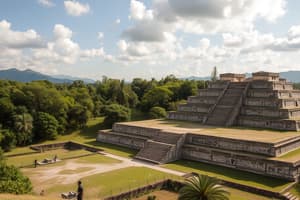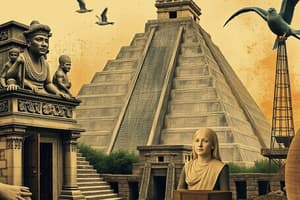Podcast
Questions and Answers
What was the primary focus of Maya art?
What was the primary focus of Maya art?
- Nature and the environment
- Religious deities
- The elite and their world (correct)
- Commoners and their daily lives
What was the primary reason for Maya military campaigns?
What was the primary reason for Maya military campaigns?
- To defend against invaders
- To conquer neighboring cities
- To expand their territory
- Various reasons (correct)
What was the primary staple crop of the Maya diet during the Preclassic period?
What was the primary staple crop of the Maya diet during the Preclassic period?
- Wheat
- Corn (correct)
- Unknown
- Rice
What was the main difference between the Classic and Postclassic periods of Maya civilization?
What was the main difference between the Classic and Postclassic periods of Maya civilization?
What was the primary purpose of Maya observatories?
What was the primary purpose of Maya observatories?
What was the primary function of Maya warriors in society?
What was the primary function of Maya warriors in society?
What was the primary function of Maya marketplaces?
What was the primary function of Maya marketplaces?
What was the primary purpose of Maya hieroglyphic writing?
What was the primary purpose of Maya hieroglyphic writing?
What was the primary material used to build Maya temples?
What was the primary material used to build Maya temples?
Flashcards
Maya Political Landscape
Maya Political Landscape
The Maya civilization was characterized by a complex political system with varying levels of complexity, including states and chiefdoms that engaged in complex relationships marked by rivalries, dominance, vassalage, and alliances.
Theopolitical System in Maya Civilization
Theopolitical System in Maya Civilization
During the Late Preclassic period, the Maya political system transitioned to a theopolitical form, where the authority of rulers was justified by religious ideology and reinforced through public displays, rituals, and religion.
Maya Political System Collapse
Maya Political System Collapse
The Maya political system was not well-equipped to adapt to change, leading to the collapse of the leadership system during the 9th and 10th centuries AD.
Maya Social Hierarchy
Maya Social Hierarchy
Signup and view all the flashcards
Maya Royal Court
Maya Royal Court
Signup and view all the flashcards
Warfare in Maya Society
Warfare in Maya Society
Signup and view all the flashcards
Trade in Maya Civilization
Trade in Maya Civilization
Signup and view all the flashcards
Maya Art and Elite Culture
Maya Art and Elite Culture
Signup and view all the flashcards
Maya City Expansion
Maya City Expansion
Signup and view all the flashcards
Study Notes
Maya civilization is known for its ancient temples and glyphs, art, architecture, mathematics, calendar, and astronomical system. The civilization developed in southeastern Mexico, all of Guatemala and Belize, and the western portions of Honduras and El Salvador. The Maya civilization is divided into three principal periods: the Preclassic, Classic, and Postclassic periods. During the Preclassic period, the Maya established the first complex societies in the region and cultivated the staple crops of the Maya diet. The Classic period is largely defined as when the Maya were raising sculpted monuments with Long Count dates. During this period, Maya cities tended to expand organically and were linked by a complex trade network. The Postclassic period saw the rise of Chichen Itza in the north and the expansion of the aggressive Kʼicheʼ kingdom in the Guatemalan Highlands. The Maya elite were literate, and developed a complex system of hieroglyphic writing. The Maya civilization occupied a wide territory that included southeastern Mexico and northern Central America. The territory of the Maya covered a third of Mesoamerica, and the Maya were engaged in a dynamic relationship with neighboring cultures. The Mesoamerican area gave rise to a series of cultural developments that included complex societies, agriculture, cities, monumental architecture, writing, and calendrical systems.Overview of Maya Civilization
-
The Maya civilization had a complex political landscape with varying levels of political complexity, including states and chiefdoms that fluctuated in their relationships with each other and were engaged in a complex web of rivalries, periods of dominance or submission, vassalage, and alliances.
-
During the Late Preclassic, the Maya political system coalesced into a theopolitical form, where elite ideology justified the ruler's authority, and was reinforced by public display, ritual, and religion.
-
The Maya political system was poorly structured to respond to changes, and this resulted in the collapse of the system of rulership during the 9th and 10th centuries AD.
-
The Postclassic period was marked by changes from the preceding Classic Period, with new cities arising near the Caribbean and Gulf coasts, and new trade networks being formed.
-
The Spanish conquest stripped away most of the defining features of Maya civilization, but many Maya villages and communities continued to manage their own affairs and maintain their traditional way of life.
-
The Maya political landscape was highly complex, and the Maya elites engaged in political intrigue to gain economic and social advantage over neighbors.
-
Maya society was sharply divided between the elite and commoners, and as population increased over time, various sectors of society became increasingly specialized, and political organization became increasingly complex.
-
Classic Maya rule was centered in a royal culture that was displayed in all areas of Classic Maya art, and the king was the supreme ruler and held a semi-divine status that made him the mediator between the mortal realm and that of the gods.
-
Maya royal succession was patrilineal, and royal power only passed to queens when doing otherwise would result in the extinction of the dynasty.
-
Maya political administration, based around the royal court, was not bureaucratic in nature, and government was hierarchical.
-
The Maya civilization had a significant impact on the development of Mesoamerican civilization, including the development of a complex writing system, the creation of monumental architecture, and the development of a sophisticated understanding of astronomy and mathematics.
-
The investigation of Maya civilization has been ongoing since the 19th century, and modern scientific archaeology has contributed greatly to our understanding of Maya civilization.Maya Society and Culture Summary:
-
Maya society was divided into nobility and commoners, with nobles holding political power and commoners comprising over 90% of the population.
-
The Maya royal court was a dynamic political institution with no universal structure, and a variety of royal and noble titles existed.
-
Warfare was prevalent in Maya society, with military campaigns launched for a variety of reasons, and little is known about Maya military organization or training.
-
Trade was a key component of Maya society, with cities controlling access to vital trade goods and portage routes, and the Maya engaged in long-distance trade across Mesoamerica and beyond.
-
Maya art is essentially the art of the royal court, with a focus on the elite and their world.
-
Maya merchants were largely middle class and engaged in local and regional trade, with elite members taking part in long-distance trading expeditions.
-
Marketplaces are difficult to identify archaeologically, but a thriving market economy existed in Maya society.
-
Maya warriors wore body armor made of quilted cotton and bore wooden or animal hide shields decorated with feathers and animal skins.
-
Maya weapons included the atlatl, darts, spears, blowguns, bows and arrows, and two-handed swords.
-
Commoners engaged in essential production activities, including that of products destined for use by the elite, such as cotton and cacao, as well as subsistence crops for their own use, and utilitarian items such as ceramics and stone tools.
-
Maya rulers were expected to be distinguished war leaders and were depicted with trophy heads hanging from their belts.
-
Different factions may have existed in the royal court, including the priesthood, the warrior aristocracy, and other aristocratic courtiers.Maya Art and Architecture
-
Maya art represents a variety of subjects and is unique in the ancient Americas in bearing narrative text.
-
Maya art has many regional styles and the finest surviving Maya art dates to the Late Classic period.
-
The Maya exhibited a preference for the colors green or blue-green and placed high value on apple-green jade.
-
Stone Maya stelae are widespread in city sites, and the hieroglyphic stairway at Copán comprises the longest surviving Maya hieroglyphic text.
-
The largest Maya sculptures consisted of architectural façades crafted from stucco, and giant stucco masks were used to adorn temple façades.
-
Maya cities were subject to irregular expansion, and most grew outwards from the core and upwards as new structures were added.
-
Maya palaces and acropoleis were essentially elite residential compounds that extended horizontally and often had restricted access.
-
Temples were raised on platforms, most often upon a pyramid, and the earliest temples were probably thatched huts.
-
The Maya built their cities with Neolithic technology, using perishable materials and stone.
-
Maya cities usually had a ceremonial and administrative center surrounded by a vast irregular sprawl of residential complexes.
-
The exteriors of most buildings were painted, either in one or multiple colors, or with imagery.
-
The Maya were keen observers of the skies and built E-Groups and observatories to track astronomical events.
Studying That Suits You
Use AI to generate personalized quizzes and flashcards to suit your learning preferences.




